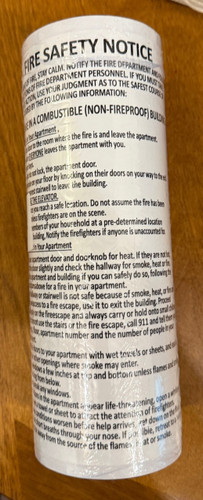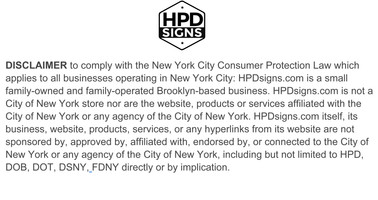100 pcs DOOR FIRE SAFETY NOTICE NON FIRE PROOF BUILDING (WHITE black letters, STICKER, 6x9 INCH,HEAVY DUTY)
- SKU:
- door : Non fire proof, combustable fire safety notice-white-roll
Description
The Importance of Having a Door Fire Safety Notice in NYC Apartment Buildings
Fire safety is one of the most critical responsibilities of property owners and managers in New York City. To protect residents, the Fire Department of the City of New York (FDNY) requires owners of residential buildings to post a Door Fire Safety Notice on the inside of every apartment entrance door. This simple but vital sign provides tenants with clear, building-specific instructions on what to do in case of a fire emergency.
Why the Door Fire Safety Notice Is Required
The FDNY recognizes that during a fire, panic and confusion can quickly set in. By posting fire safety instructions at the most visible location—the back of every apartment door—residents are reminded of the proper procedures they should follow before an emergency ever occurs. This compliance measure:
-
Reinforces life-saving fire safety rules.
-
Provides immediate guidance for tenants who may not remember safety plans during a crisis.
-
Meets legal posting requirements for residential property owners.
-
Reduces the risk of injury, fatalities, and property damage during a fire.
Fireproof vs. Non-Fireproof Buildings
One of the most important distinctions in FDNY fire safety rules is whether a building is fireproof or non-fireproof. The instructions posted on the Door Fire Safety Notice differ based on this classification:
-
Fireproof Buildings (usually high-rise construction):
-
Tenants are generally instructed to stay inside their apartment if a fire occurs elsewhere in the building, unless the fire is in their unit.
-
Fireproof construction is designed to contain flames and smoke, giving residents more time and protection.
-
The Door Fire Safety Notice emphasizes staying put, sealing doors, and calling 911 unless evacuation is absolutely necessary.
-
-
Non-Fireproof Buildings (typically low-rise or older construction):
-
Tenants are usually instructed to leave the building immediately in the event of a fire.
-
These buildings lack the same flame-resistant barriers, so smoke and fire can spread quickly.
-
The Door Fire Safety Notice highlights safe evacuation routes and stresses exiting without delay.
-
This distinction can save lives by ensuring residents follow the right protocol for their specific building type.
FDNY Rules and Compliance Requirements
The FDNY mandates that:
-
All apartment entrance doors in residential buildings must have a Door Fire Safety Notice posted on the inside.
-
The notice must be in the FDNY-approved format, with clear instructions tailored to the building type.
-
Owners are responsible for ensuring that signs remain legible, intact, and correctly posted at all times.
-
Notices must be updated if building classification or regulations change.
Failure to comply can result in violations, fines, and liability in the event of an emergency.
Benefits Beyond Compliance
Posting a Door Fire Safety Notice isn’t just about meeting FDNY requirements. It demonstrates that building owners and managers are committed to:
-
Protecting tenant safety
-
Building trust with residents
-
Reducing legal exposure and insurance risks
-
Creating a culture of fire safety awareness
By taking this simple step, property owners ensure that every tenant has vital information at their fingertips when it matters most.
Conclusion
The Door Fire Safety Notice is a small but powerful tool in NYC’s fire safety framework. Whether in a fireproof high-rise or a non-fireproof low-rise, this FDNY-mandated notice provides clear, building-specific instructions that can make the difference between life and death during a fire. For building owners, compliance is not just a legal requirement—it’s a moral responsibility to safeguard the lives of tenants and their families.
DISCLAIMER
We are a small, family-owned and family-operated Brooklyn-based business. We are not a City of New York store, nor are our website, products, or services affiliated with the City of New York or any agency of the City of New York. Neither we, nor our business, websites, products, services, or any hyperlinks from our website are sponsored by, approved by, affiliated with, endorsed by, or connected to the City of New York or any agency of the City of New York, including but not limited to HPD, DOB, DOT, DSNY, FDNY, or any federal entity, directly or by implication.
DISCLAIMER ON LEGAL CODES
The codes, regulations, and requirements referenced on our website may not represent the most recent or updated versions. State, federal, or local regulatory agencies may have more current or accurate information. We make no warranties or guarantees about the accuracy, completeness, or adequacy of the information provided on this site or linked from it. Customers should verify all information by reviewing the official sources directly.
DISCLAIMER ON SIGN USE
The requirements for sign content depend on intended use and applicable laws. The buyer is solely responsible for determining the appropriate content for a sign or package of signs. We make no warranty or representation regarding the suitability of any sign for a specific application. It is the customer’s responsibility to ensure that the signs ordered are in compliance with all applicable state, federal, local, and municipal laws. Customers are encouraged to carefully review our Terms and Conditions prior to purchase.
GENERAL INFORMATION DISCLAIMER
All content on this site is provided for informational purposes only and does not constitute legal advice, professional advice, or a definitive statement of law. For guidance on specific requirements, customers should consult the laws and regulations referenced, as well as any rules applicable in their jurisdiction. You may wish to consult with an attorney or qualified professional to ensure compliance with all applicable legal obligations.
Write a Review

100 pcs DOOR FIRE SAFETY NOTICE NON FIRE PROOF BUILDING (WHITE black letters, STICKER, 6x9 INCH,HEAVY DUTY)






